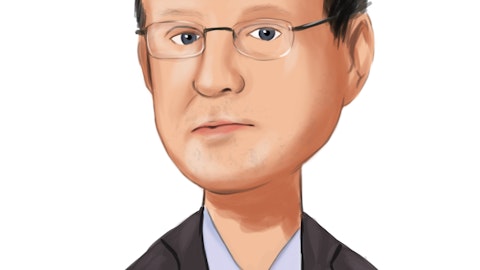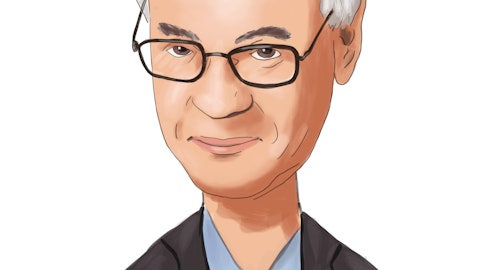Karl Shepard: Yes, that’s fair, I appreciate the help. And then switching gears in terms of lending. Like I hear the kind of the positive comments on replenishing the pipeline. But I also noticed in the deck kind of a tick down in line utilization. So I was hoping you could kind of square those two comments and just give an overview, maybe kind of what the general loan demand trends are and what you’re hearing from borrowers?
Todd Clossin: Yes, and I’ll maybe I’ll answer the first part of that, and then I’ll throw it to Jeff, and let him answer the second part of it. But we saw a high point in terms of utilization, just a hair under 45%, like 44.4%, back at the end of 2019, prior to the pandemic. And that’s continued to trend down to $32.5 as we stated in our in our comments. And I think part of that may be stemming from the higher interest rates that a lot of those lines are variable rates, and with the delta between the deposits what they’re getting on deposits and what they’re getting having to pay on the loan side. I think that there’s a lot of lines being paid down right now with the excess liquidity. So I think that’s driving some non-interest bearing deposit declines, but also driving down line utilization as well, too.
Having said that, we are But that could actually work into everyone’s favor, our favor as well, too. If the increase the stop and the cuts start to occur later in the next year, then that takes some of the pressure off. And I think again, our funding advantages are really show through and we’ll be able to manage the deposit base a little easier than we’re having to if rates continue to go up. So I think that’s a good possibility. It’s hard. This is not a lot of clarity into the third quarter right now.
Karl Shepard: Yes, that’s fair, I appreciate the help. And then switching gears in terms of lending. Like I hear the kind of the positive comments on replenishing the pipeline. But I also noticed in the deck kind of a tick down in line utilization. So I was hoping you could kind of square those two comments and just give an overview, maybe kind of what the general loan demand trends are and what you’re hearing from borrowers.
Todd Clossin: Yes, and I’ll maybe I’ll answer the first part of that, and then I’ll throw it to Jeff, and let him answer the second part of it. But we saw a high point in terms of utilization, just a hair under 45%, like 44.4%, back at the end of 2019, prior to the pandemic. And that’s continued to trend down to 32.5 as we stated in our in our comments. And I think part of that may be stemming from the higher interest rates that a lot of those lines are variable rates, and with the delta between the deposits what they’re getting on deposits and what they’re getting having to pay on the loan side. I think that there’s a lot of lines being paid down right now with the excess liquidity. So I think that’s driving some non-interest bearing deposit declines, but also driving down line utilization as well, too. Having said that, we are pretty well positioned with regard to our loan portfolio for growth. Jeff, do you want to jump in?
Jeff Jackson: Sure. Thanks, Todd. Yes, as we mentioned, our pipeline is around $1.1 billion that’s near an all time high. We do have a lot of projects that have kind of slowed down, I think with rates rising. But once again, we’re seeing a pretty robust pipeline, and feel really good about where we stand from a business perspective. A lot owners, some of their banks have stopped lending. So we’re getting opportunities there as well. And we are taking up our prices also, as rates have risen. So I think we’re really well positioned to go forward and have not seen any real slowdown from business perspective for us.
Todd Clossin: Yes. Jeff mentioned, the higher deposit or the higher loan rates. We are up 75 to 100 basis points in terms of kind of the floors on our originations over where we were just a couple of months ago. So we realized not a lot of banks are lending money out there, right now, we’re in a position to be able to continue lending, but we’re going to get paid for it. So we want to make sure what those higher funding costs, particularly from federal one bank, that we’ve got a margin on top of that, that makes sense for us. And that may impact pipelines, that may impact loan growth by a percentage point or two, although we’re not seeing it yet. It might impact it by a percentage point or two, but we’re going to get the margin. So that margin so that we’re focused on the beta, the margin beta and not just the deposit beta. So that means the home price needs to continue to go up, particularly if the Feds going to keep raising rates.
Karl Shepard: That’s great. Thanks, Tom.
Todd Clossin: Sure.
Operator: Our next question comes from Catherine Mealor from KBW. Please go ahead.
Todd Clossin: Good morning Catherine.
Catherine Mealor: Hey, good morning. Just one more on the funding side. on FHLB borrowings that you prefer to stay under to try to think about, as we made you grow FHLB a little bit more versus CDs where you’re kind of sticking point is there?
Todd Clossin: Yes, Catherine. So I would say, high level, our maximum borrowing capacity from FHLB is about 4.6 billion. And as you know, we’ve got about 1.3 billion borrowed at this point. So that leaves our remaining capacity about 3.3 billion. There’s not necessarily, we don’t necessarily view this as a cap, I mean, or we don’t have necessarily a cap, I think we certainly would love to not borrow from the Federal Home Loan Bank and generate our funding through low cost deposits. But it’s not unusual over the years for us to be holding really, on average, about a billion dollars from the Federal Home Loan Bank anyways pre-pandemic, we were right around on a smaller balance sheet. So not necessarily unusual, but I wouldn’t say that we’ve got a cap per se.
But we obviously are continuing to monitor that. As you heard in my prepared commentary, we did take out some broker deposits, we did $140 million there, that was more, just to kind of tap into the market to confirm that we had access to those funds. And, of course, that obviously, also, from my perspective, really is wholesale borrowing similar costs to FHLB before as well. And that provides some additional availability, if you think about it that way. But no, there’s not. specifically, I wouldn’t say we have a defined cap on where there’s borrowings would be.
Catherine Mealor: Great. And then maybe switching over to deposits, kind of thinking about the non-interest bearing mix shift. And you touched on this just a little bit. But is there any reason, as you just kind of think about your deposit base and your borrowers, is there anything as you see within your deposit base, that could make the case, and we should still stay kind of above the pre-pandemic levels in terms of percentage of noninterest bearing to total? Or what’s preventing that from actually going maybe even lower than pandemic levels? We’re just kind of looking at non-interest bearing mix shift across the industry, there’s a big discussion, I think, today for everybody is where these numbers eventually go. And there’s any kind of commentary you can give on maybe what’s different or special about your deposit base that may protect you there.
Todd Clossin: Yes. It’s great question. So my answer to that would be that we do look at kind of where we are at pre pandemic, right. So we’ve completed the online bank merger back in November of 2019. So we got a good quarter comparison of our current size three years ago, prior to the pandemic. So we tend to look at kind of where were we out there and in a normal world, I guess would you revert back to that at some point in time. There’s pushes and pulls to that. What I would say the pull to that would be that you’re talking about 5% maybe 6% with CD rates and things like that, that are out there, that’s a big delta, versus where it was three years ago with the rates being a lot lower. So where people are going to be more apt to better utilize their cash so to speak, to get a return.
We’re seeing some of that with the line pay downs. But are we going to see that it is going to be different than it was three years ago, because the delta is so big, but then fighting against that it’s going to be I think the Fed would be cutting rates here at some point. So that that delta is going to start to diminish and maybe it gets back to where it was three years. I don’t think I’ll go quick back that far. So that could make the case for you could go lower than you were pre-pandemic but I would also say that we’re doing a lot of things differently now than we were then because we’re getting a lot better at generating what I would say core deposits and having plans around that. We’ve benefited from the hare related deposit just kind of fallen into the bank, and our legacy footprint.
So we never had to really sharpen our pencil, so to speak, because funding was always readily available. But now as we kind of look through that, with our loan growth and our plans and everything, we’ve gotten better at being able to generate core deposits. We’ve added a pretty significant part of our commercial lending incentive plan is now deposit driven, whereas in prior years, it wasn’t because we were focused on loan growth and margin on loans, but not necessarily deposits. So that’s changed. So we’re getting much, much better at that side of things. We have new treasury management products, several which Jeff has brought to the table with what I would say more C&I related treasury management that we’re going to market with that could be a real game changer for us as well, too.
So we’re doing some things that we weren’t doing three years ago that I would say, would allow us to operate at a higher percentage of non-interest bearing than where we were at three years ago. So there’s pushes and pulls to that. We’ll have to wait and see how it works out. But that’s kind of the way that we see it right now. And I would tend to land in the spot that I would expect higher non interest bearing deposits, as a percentage of our deposit base than where we were at three years ago. But I just don’t know where that, kind of where that bottom or that floor is or where that point is. And we’ll have to just find that out over the next couple of quarters as we move through the cycle.
Catherine Mealor: Great, that’s really helpful. And maybe just switching to credit, I mean you added some great slides in your deck on just your office portfolio and commercial real estate portfolio. And then from old line, you’ve now got exposure to DC, which is getting so much negative press about the office landscape there. But it’s glad to see that the actual DC piece is very small for you. It’s much more kind of , so guess this just give any commentary on what you’re seeing, particularly in that market and what you’re worried about any kind of risky scene here or alternatively, what makes you more comfortable with your office portfolio? Thanks.





